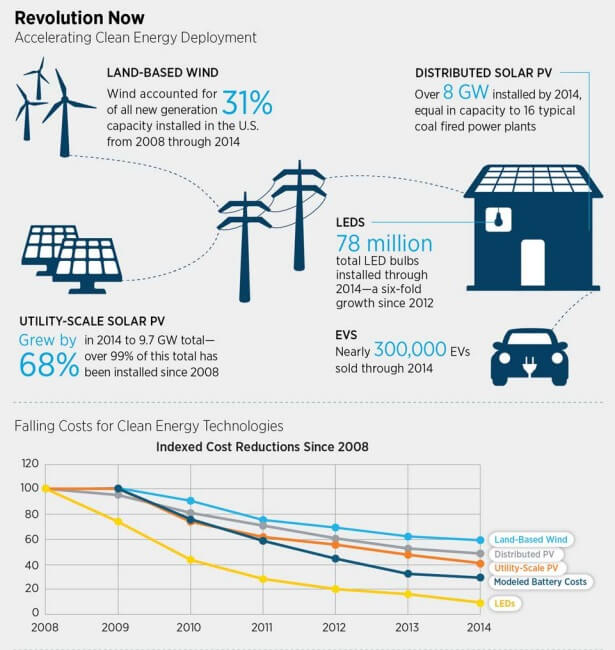The Energy Department recently released the 2015 Revolution…Now report, detailing the state of several clean energy technologies available today in the United States, which provide technology solutions to climate change. The updated report builds upon the past Revolution…Now report, showing dramatically increasing deployment and decreasing costs of four transformational technologies: wind turbines, solar technologies, electric vehicles (EVs), and light-emitting diodes (LEDs).

One 1 gigawatt = 1,000 MW. All costs shown are inflation adjusted to dollar year 2014 and exclude the production tax credit. Wind capacity as reported by market reports. “Wind Cost” represents estimated levelized cost of energy from a representative wind site, and “Lowest Wind Cost” represents costs derived from power purchase agreements from good to excellent wind resource sites in the interior of the country.
The 2015 update shows that impressive cost reductions continue to drive adoption of clean energy technologies. The report covers the rapid growth of photovoltaic (PV) solar modules for both large, utility-scale PV plants and smaller, rooftop, distributed PV systems that have achieved significant deployment nationwide.
The findings include:
- Between 2008 and 2014, land-based wind energy accounted for 31% of all new installed U.S. generation capacity, in part due to early investments from the Energy Department
- By 2014, more than eight gigawatts of distributed solar PV were installed, which is enough to power roughly one million American homes
- An average EV reduces greenhouse gas emissions by 48% compared to a gasoline-powered car; the emissions avoided by the nearly 300,000 EVs sold in the United States through 2014 is equivalent to taking nearly 150,000 gasoline-powered cars off the road
- A total of 78 million LED bulbs have been installed through 2014, a six-fold increase since 2012.
From the executive summary:
For decades, America has anticipated the transformational impact of clean energy technologies. As the federal government and industry made long-term investments to support those technologies, some critics became impatient, claiming a clean energy future would “always be five years away.” Today, the clean energy future has arrived.
In 2013, the U.S. Department of Energy (DOE) released the Revolution Now report, highlighting four transformational technologies: land-based wind power, silicon photovoltaic (PV) solar modules, light-emitting diodes (LEDs), and electric vehicles (EVs). That study and its 2014 update showed how dramatic reductions in cost are driving a surge in consumer, industrial, and commercial adoption for these clean energy technologies—as well as yearly progress.
In addition to presenting the continued progress made over the last year in these areas, this year’s update goes further. Two separate sections now cover large, central, utility-scale PV plants and smaller, rooftop, distributed PV systems to highlight how both have achieved significant deployment nationwide, and have done so through different innovations, such as easier access to capital for utility-scale PV and reductions of non-hardware costs and third-party ownership for distributed PV.
Along with these core technologies, this update briefly introduces three additional technologies on the cusp of wider deployment and cost reduction in the coming years: smart building systems, fuel-efficient freight trucks, and vehicle lightweighting.
Today, clean energy technologies are providing real-world solutions—not only do they reduce the carbon pollution that causes climate change, but they also drive a domestic energy economy with technologies that are increasingly cost-competitive with existing conventional technologies, even without accounting for the climate benefits. Clean energy manufacturing and installations have also become major opportunities for American workers in the 21st century.
Even though we are seeing the results of the enormous progress these technologies have achieved, there is still more that can be accomplished. DOE’s recent Quadrennial Technology Review identified hundreds of clean energy research and innovation opportunities in our homes, businesses, cars and trucks, and in the power sector, that with sustained investment will provide real-world solutions to our energy challenges.
With the continued progress of the core technologies in this report, and more innovations on the horizon, the clean energy revolution is clearly transforming the way we produce and use energy.
Big fans of wind power
Wind power is firmly entrenched as a mainstream power source: between 2008 and 2014, wind power accounted for 31% of all new generation capacity added in the United States. As of 2014, there were more than 65,000 megawatts (MW) of utility-scale wind power deployed across 39 states5—enough to generate electricity for more than 16 million households6—with another
13,600 MW under construction as of the first quarter of 2015.7 Wind now provides 4.4% of total U.S. electricity generation, 23 states have at least 500 MW of wind installed, and in nine states, wind exceeds 10% of total in-state electricity generation.
This ramp up in generation has yielded enormous benefits: wind power in the United States in 2013 reduced annual carbon dioxide emissions by more than 115 million metric tons and reduced water consumption by more than 36 billion gallons, all while supporting more than 50,000 U.S. manufacturing, construction, and wind operations jobs.
For the full report: http://energy.gov/sites/prod/files/2015/11/f27/Revolution-Now-11132015.pdf
Filed Under: News





